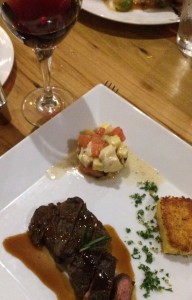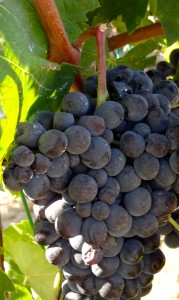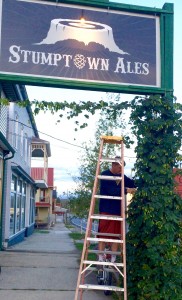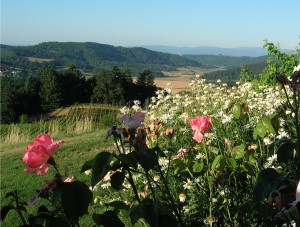There is no question about it: I love to use my trusty Weber grill to barbecue all type of meat products, including pork spare ribs, beef steaks, whole chickens, rack of lamb and seafood, especially salmon. The wine choices for these edible treats are usually medium to full-bodied reds like zinfandel, cabernet sauvignon or syrah.
But I am also a fan of using my Weber to grill vegetables, particularly now that we have access to the bounty of the summer season. There is no better time than right now to add more vegetables to the daily dinner table. And since I love to purchase locally grown foods, I spend a great deal of time perusing the aisles of Capitol Market ‘s outdoor section for the fresh produce picked daily by area farmers.
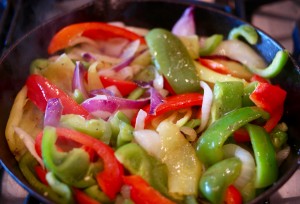
Right now, you can find just about any vegetable, including corn, green beans, squash, sweet and hot peppers and, of course, tomatoes. With a little preparation and a lot of imagination, you can coax a whole new palate of flavors out of veggies when you grill them.
Grilling these edible plants also creates an added benefit for we wine lovers. The smoky, slightly charred flavors add a taste dimension that enables normally delicate vegetables like green beans, zucchini squash and broccoli to pair very well with medium bodied whites like sauvignon blanc. And my new “go-to” sauvignon blanc is the 2015 Chateau Fontenille ($12), a white Bordeaux that is the perfect match to the aforementioned grilled veggies.
But you don’t need a grill to enjoy these delicious vegan treats. In fact, one of my favorite summertime vegetable dishes is best prepared in the kitchen. The centerpiece of the dish is peppers. And man do I love peppers! Green ones, red ones and especially hot ones. I use peppers in a multitude of ways. I roast them, stuff them, fry them, freeze them, can them and, above all, I consume them almost daily.
Here’s a recipe for fried peppers I’ve borrowed from members of my Italian-American family. I’ve told you about it before, but it is worth repeating here today. This dish demands a medium bodied red wine with a good dollop of acid to enhance the flavors of the peppers. Try one or all three of these wines with the dish: 2013 Easton Monarch Mine Barbera ($25); 2012 Vietti 'Tre Vigne' Barbera d' Asti ($17); 2013 Elk Cove Willamette Valley Pinot Noir ($26).
Fried Peppers Calabraze
Ingredients
Seven multi-colored bell peppers, sliced into five-inch long by one-inch wide pieces
Three hot banana peppers (optional) sliced the same as above
One large onion sliced into approximately three-inch lengths, a quarter-inch wide
One large ripe, red tomato, peeled and coarsely chopped
Three garlic cloves coarsely chopped
Three ounces of olive oil
Two tablespoons each of freshly chopped basil and oregano
One teaspoon of salt and coarsely ground black pepper
How To
Heat olive oil in a large frying pan (preferably cast iron) to medium high heat
Add onions and sauté for about three minutes, and then add all peppers
Use a spatula to stir the peppers regularly to prevent ones on bottom from burning
Add garlic and tomatoes to the mixture after about 15 minutes and continue stirring
Lower heat and cook until most of the liquid evaporates
Continue to sauté until the peppers and onions begin to caramelize (usually takes 25-to 30 minutes)
Remove from the stove, place in a large bowl and season with salt and pepper
Mix in the fresh basil and oregano and then serve
But I am also a fan of using my Weber to grill vegetables, particularly now that we have access to the bounty of the summer season. There is no better time than right now to add more vegetables to the daily dinner table. And since I love to purchase locally grown foods, I spend a great deal of time perusing the aisles of Capitol Market ‘s outdoor section for the fresh produce picked daily by area farmers.

Right now, you can find just about any vegetable, including corn, green beans, squash, sweet and hot peppers and, of course, tomatoes. With a little preparation and a lot of imagination, you can coax a whole new palate of flavors out of veggies when you grill them.
Grilling these edible plants also creates an added benefit for we wine lovers. The smoky, slightly charred flavors add a taste dimension that enables normally delicate vegetables like green beans, zucchini squash and broccoli to pair very well with medium bodied whites like sauvignon blanc. And my new “go-to” sauvignon blanc is the 2015 Chateau Fontenille ($12), a white Bordeaux that is the perfect match to the aforementioned grilled veggies.
But you don’t need a grill to enjoy these delicious vegan treats. In fact, one of my favorite summertime vegetable dishes is best prepared in the kitchen. The centerpiece of the dish is peppers. And man do I love peppers! Green ones, red ones and especially hot ones. I use peppers in a multitude of ways. I roast them, stuff them, fry them, freeze them, can them and, above all, I consume them almost daily.
Here’s a recipe for fried peppers I’ve borrowed from members of my Italian-American family. I’ve told you about it before, but it is worth repeating here today. This dish demands a medium bodied red wine with a good dollop of acid to enhance the flavors of the peppers. Try one or all three of these wines with the dish: 2013 Easton Monarch Mine Barbera ($25); 2012 Vietti 'Tre Vigne' Barbera d' Asti ($17); 2013 Elk Cove Willamette Valley Pinot Noir ($26).
Fried Peppers Calabraze
Ingredients
Seven multi-colored bell peppers, sliced into five-inch long by one-inch wide pieces
Three hot banana peppers (optional) sliced the same as above
One large onion sliced into approximately three-inch lengths, a quarter-inch wide
One large ripe, red tomato, peeled and coarsely chopped
Three garlic cloves coarsely chopped
Three ounces of olive oil
Two tablespoons each of freshly chopped basil and oregano
One teaspoon of salt and coarsely ground black pepper
How To
Heat olive oil in a large frying pan (preferably cast iron) to medium high heat
Add onions and sauté for about three minutes, and then add all peppers
Use a spatula to stir the peppers regularly to prevent ones on bottom from burning
Add garlic and tomatoes to the mixture after about 15 minutes and continue stirring
Lower heat and cook until most of the liquid evaporates
Continue to sauté until the peppers and onions begin to caramelize (usually takes 25-to 30 minutes)
Remove from the stove, place in a large bowl and season with salt and pepper
Mix in the fresh basil and oregano and then serve

